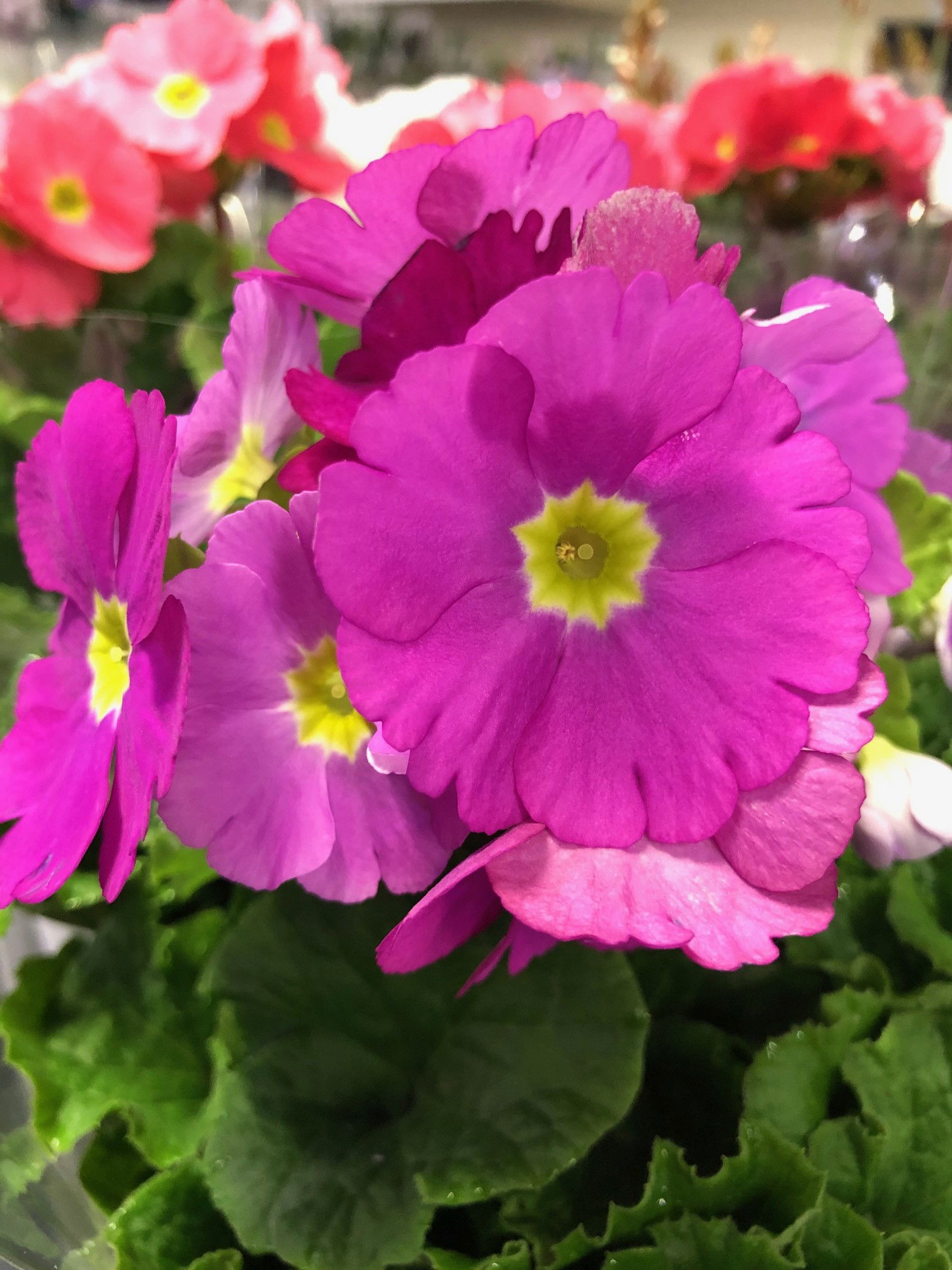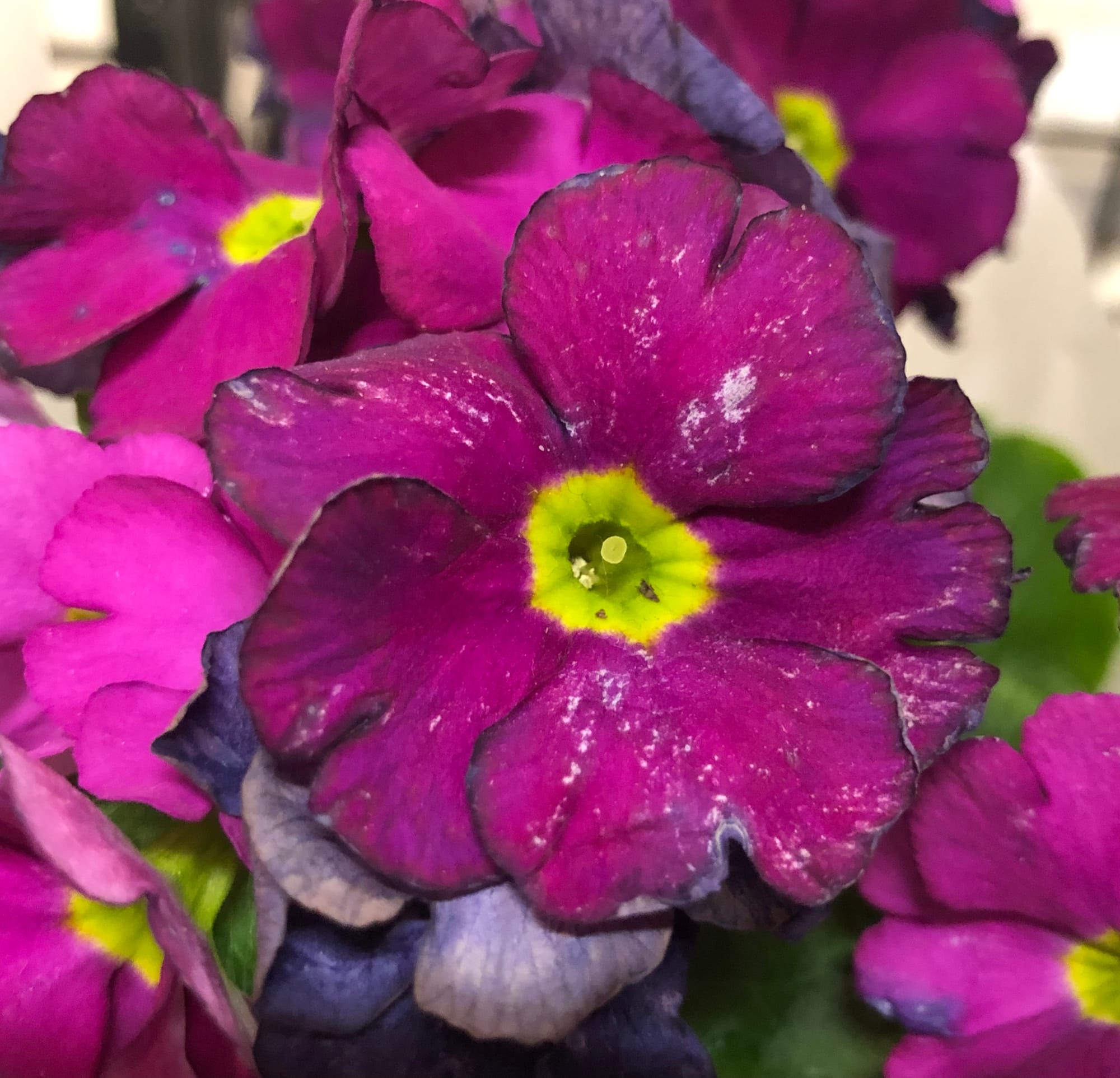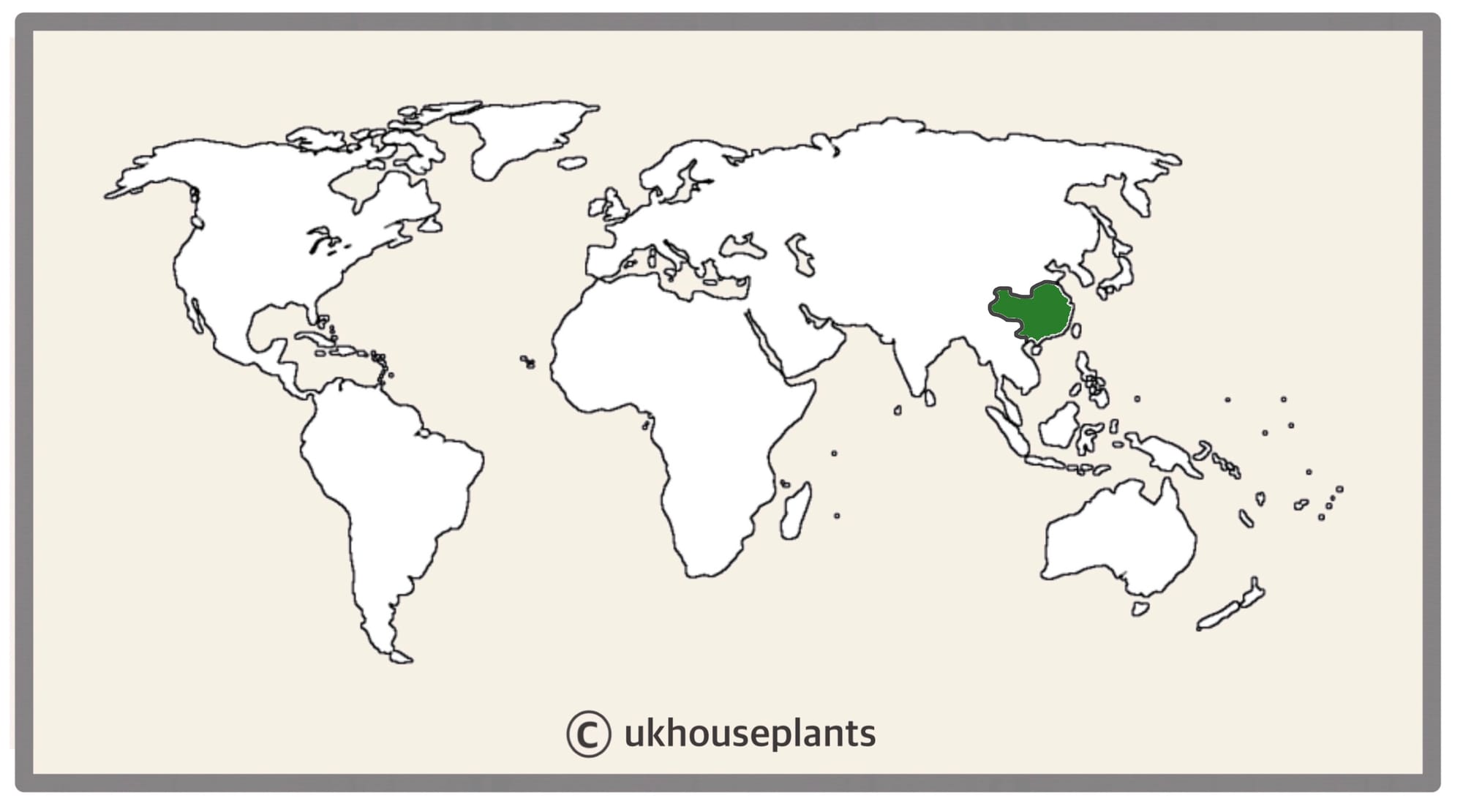
Primula obconica
Contents
- Top Tips
- Location, Water, Humidity & Fertilisation
- Dormancy Care & Annual Flowers
- Common Issues
- Origins, Temperature, Propagation, Repotting & Toxicity.
Need the answer to a specific plant query? Book a 1-to-1 video call with Joe Bagley, the website's friendly author to overcome and address your niggling problem! Available on iMessage, WhatsApp, Facebook Messenger & more.
Top Tips & Info
- Care Difficulty - Moderate
- Bright, indirect light is optimum as locations that are too dark will increase the likelihood of basal rot and plant collapse. Avoid more than one hour of direct sunlight per day, especially in the height of summer.
- We'd recommend locating yours on a north-facing windowsill, or within a metre of an east, south or west-facing window.
- Keep the soil evenly moist whilst in flower, using lukewarm water and the bottom-up method of irrigation. Once the final inflorescence elapses, reduce irrigation and fertilisation slightly to ease the specimen into dormancy.
- Average room humidity is more than acceptable for Primroses - never situate it within three metres of an operating heat source to avoid dehydration.
- Supplement fortnightly using a potassium-based feed (like Tomato or Streptocarpus feed) whilst in bloom, reverting to a 'Houseplant' labelled fertiliser at monthly intervals after flowering. A 'Houseplant' feed can be used as a sole-fertiliser throughout the year, though.
- Scroll down to 'Dormancy Care & Annual Flowers' to learn about achieving bloom show of blooms per year.
- If your specimen has issues of basal rot, which can develop grey mould and (Botrytis), scroll down to 'Common Issues' for more information on addressing this problem.
- Finally, once your specimen has finished flowering, be sure to provide a cooler location with good lighting - a north-facing window comes to mind. Once the risk of frost elapses in mid-spring, you can safely place the plant in the garden, so that it can flower in the following winter.
Location & Light - 🔸🔸🔸
We'd recommend a location that offers a splash of morning or evening sunlight is the ideal setting. Shady spots must be avoided at all costs due to the increased chance of over-watering and crown rot (if watered from above).
The ideal room of the house would be anywhere that's above 15ºC (59ºF) and is at least three metres away from an operating heat source. Try placing the plant on a north, east or west-facing windowsill, or around two metres from a south-facing window. It's essential to provide a splash of winter sunlight to prevent the chance of foliage or root rot.
Water - 🔸🔸
Throughout the blooming period, Primroses must be sat in moist soil for most of the time. Allow the pot to become slightly light in between hydrations, using the bottom-up method. Splashing the flowers and leaves each time you come to water the plant will result in the foliage beginning to rot. Place the pot on a saucer one water, around one-quarter deep, until thorough absorption. You may have to repeat this twice a week if needs be, especially with those grown in bright, warm locations. Try not to use cold water during this period, to avoid shocking their tender root systems. Under-watering symptoms include rapid flower loss and dry, crispy leaves - these issues are usually due to either forgetfulness, too much sunlight or too much heat. Even though an under-watered Primrose is far better than a soggy one, never allow the soil to thoroughly dry out for too long as this could cause flower or leaf loss. Over-watering symptoms include rotting lower leaves, yellowing leaves, a loss of buds & flowers and root or crown rot. Allow most of the soil to dry out in between waters and prevent a pool of standing water accumulate beneath the pot.
Humidity - 🔸🔸
Average room humidity is enough to satisfy this plant, as long as you don't live in an overly-dry climate. Never situate it within a few metres of an operating radiator due to the enriched chance of browning leaf-tips. If you are indeed worried about dry air, create a humidity tray to provide a moist and stable environment for your plant, which will also have the added benefit of slowing the rates of drying soil!
Fertilisation - 🔸
We'd recommend fertilising your specimen once every two to four weeks in the spring and summer, and monthly thereafter using a 'Houseplant' or 'Streptocarpus' labelled feed. A general plant fertiliser is acceptable too, but remember to dilute the solution by half to prevent the burning of roots.
Dormancy Care & Annual Flowers
Achieving a winter bloom isn't the hardest of tasks, with those who have a cooler room without artificial light at night being on the upper-hand. The following steps should be done at the start of autumn when the plant's growth starts to slow down. Always think of ukhouseplants' acronym of SHORT when it's time for flowers.
Indoor Primroses better off staying pot bound for several reasons, including the prevention of root rot or transplant shock, and to put momentarily stress on the plant. Although this may sound harsh, a restriction of roots is the best way to obtain flowers, as it'll send out a spike in response to becoming under threat. As long as the plant is subsequently repotted tri-annually in the spring, no harm is done.
N. B. - Most people will discard or plant the Primrose in the garden once the flowers have elapsed - this method is great for those who want to keep it, but can't provide specialist care over the next year.
Sunlight & Location
Be sure to provide a bright location with little to no direct sunlight. Although the winter rays won't necessarily hurt the plant, you can easily fall in the trap of sun-scorch and severe dehydration.
For the Primrose to fully become seasoned, avoid the use of artificial lighting or locations that boast temperatures higher than 18℃ (64℉).
Hydration
Reduce waters so that about half of the soil becomes dry. It's essential to keep them on the drier side to life, as they'll think that hard times are ahead and therefore will need to pass its genes on to the next generation.
Occasional Feeds
While in bloom, use a Tomato fertiliser to provide monthly nourishment of potassium.
Reduce Everything
This one is to remind you that everything needs to be reduced - especially the temperature.
Temperature
This is the most significant step; reduce the temperature down by around 5℃ compared to the summertime or place in a room that's around 12℃ (54℉). The drop in temperature should ideally last until the inflorescence finishes blooming, although it can still be transferred into the main house as long as it sits on a pebble tray. You'll be at a significant disadvantage if the ambient temperature is kept constant throughout the year, as Primroses will only respond with flowers in cooled environments. Never exceed the minimum temperature as it could lead to plant death or yellowed foliage at a bare minimum.
Common Issues with Primroses
Over-watering is the biggest issue, with typical signs of this include brown leaves with soft spots on the underside of the leaves, basal/crown rot or powdery mildew forming in the centre. Not only do you have to be mindful of these problems, but also have a think about which plant parts to keep dry. Its central crown must also remain dry at all times to prevent the development of basal rot or mildew. Avoid waterlogging; there's no point fulfilling the ukhouseplants' phrase, 'drenches in between near-droughts' if the base of the pot is submerged, as root rot will arise. For any more information about over-watering related issues, be sure to click on this link.
Too much sunlight will lead to sun scorch, with typical signs including browning or crispy leaves, dry leaf-edges, sunken leaves or stunted growth. Although too little light will cause over-watering issues, too much sunlight will negatively affect the plant as well. A location that offers over two hours of sunlight a day will bring the optimum growth for the Primrose. If yours has fallen short of this issue, reduce the amount of sunlight considerably and always be mindful of environmental shock (when too locations offer too different growing conditions). Remove some of the affected leaves and increase irrigations slightly. Only hydrate the plant using the bottom-up method.
 When the flower's petal edge begins to curl, it means there'll only be around one more week before it'll die. Remember to prune spent blooms to encourage further flowering!
When the flower's petal edge begins to curl, it means there'll only be around one more week before it'll die. Remember to prune spent blooms to encourage further flowering!
As mentioned before, powdery mildew and Botrytis are major threats among heavy foliaged plants due to the compact nature that aids the spread of the diseases. Watering above the foliage will allow excess moisture to sit in the cubbyholes of the stem, enticing harmful bacteria to thrive. Remove the affected areas and improve the growing conditions by situating the plant in a brighter location with the use of the bottom-up method of irrigation.
A lack of flowers is caused by an insufficient dormancy period, served in the winter months. Locations that offer near-similar temperatures all year round won't allow the plant to go dormant, resulting in low spring growth. To achieve, situate in a location that dips to around 12°C (54°F) with fewer waters. Allow the majority of the compost to dry out and provide a humidity tray while the radiators are operating.
 Pink varieties are among the most popular across Europe, with others being white, purple and orange.
Pink varieties are among the most popular across Europe, with others being white, purple and orange.
Origins
Primula is a perennial genus consisting of over five hundred species, along with a hundred hybrids and cultivars. They originate largely from the Himalayas but can be found in temperate locations in central Africa and South America. The genus was first described back in the 1750s by Carl Linnaeus, using the Latin word for 'prime', which is in reference to their flowers being one of the first to show in spring.
 The Distribution of the most popular indoor Primrose, Primula obconica.
The Distribution of the most popular indoor Primrose, Primula obconica.
Temperature
3° - 22°C (37° - 72°F)
H1c (Hardiness Zone 11) - Can be grown outdoors between late spring and summer throughout most of the UK while nighttime temperatures are above 8℃ (46℉). If you decide to bring the plant outdoors, don't allow it to endure more than an hour of direct sunlight a day as it may result in sun-scorch. Regularly keep an eye out for pests, especially when re-introducing back indoors.
Spread
Up to 0.3m in height and 0.4m in width. The ultimate height will take between 4 - 6 years to achieve.
Pruning & Maintenance
Remove yellow or dying leaves, and plant debris to encourage better-growing conditions. While pruning, always use clean utensils or shears to reduce the chance of bacterial and fungal diseases. Never cut through yellowed tissue as this may cause further damage in the likes of diseases or bacterial infections. Remember to make clean incisions as too-damaged wounds may shock the plant, causing weakened growth and a decline in health.
Propagation
Via Seed or Basal Offset Division.
Basal Offset Division (Easy) - The ideal time to divide is during the repotting period. Gently tease away some of the soil, and separate a few basal offsets which have its own root system. Place the plantlet in moist 'Houseplant' compost and be sure you don't submerge its leaves or basal cubbyhole into the soil. Keep the soil relatively moist and place it in a bright, indirect location to avoid the risk of dehydration (a common trait of death). This method can be relatively straightforward; however, be mindful of transplant shock, whereby its root systems are severely over-touched, which may result in excessive wilting.
Flowers
Primroses are a tender perennial, meaning that as long as the temperature doesn't dip below 5°C, it should re-flower in the following winter or early spring. Each flower can last up to ten days, with the overall show lasting three weeks. Always avoid misting or saturating the petals, as you'll run the risk of developing botrytis petal blight.
Repotting
Repot every three years in spring using a 'Houseplant' labelled potting mix and the next sized pot with adequate drainage. Primroses are far better potbound for several years due to the heightened risk of root rot and repotting-issues (like transplant shock), so only repot if you feel it's wholly necessary - restricted root growth will also increase the chance of blooms, too.
Hydrate the plant 24hrs before the tinkering with the roots to prevent the risk of transplant shock. For those situated in a darker location, introduce an extra amount of perlite and grit into the deeper portion of the pot to downplay over-watering risks. Click on this link for a detailed step-by-step guide on transplantation, or via this link to learn about repotting with root rot.
Pests & Diseases
Keep an eye out for mealybugs, aphids, fungus gnats, slugs & root mealybugs that'll locate themselves in the cubbyholes and undersides of the leaves, with the exception of the latter in soil. Common diseases associated with Primroses are root rot, leaf-spot disease, Botrytis, rust, powdery mildew & southern blight - click here to learn more about these issues.
Toxicity
This plant is classified as poisonous, so if small sections are eaten, vomiting, nausea, and a loss of appetite may occur. Consumption of large quantities must be dealt with quickly; acquire medical assistance for further information.
Retail Locations
Some florists & Online Stores. Specimens are likely to be found in winter or spring inside at most garden centres; it's not advised to bring outdoor plants back indoors as this could lead to environmental shock with the risk of introducing pests into the home.
Book a 1-to-1 Call with Joe Bagley
If you need further advice with your houseplants, book an advice call with ukhouseplants' friendly and expert writer today! This can be done via a video or audio call on most apps, including Facebook, FaceTime & Skype. A ten-minute call costs £5.99 (US$7), or £15.99 for thirty minutes. You can ask multiple questions, including queries on plants, pests, terrariums, repotting advice and anything in between. Please consider supporting this service to keep ukhouseplants thriving!